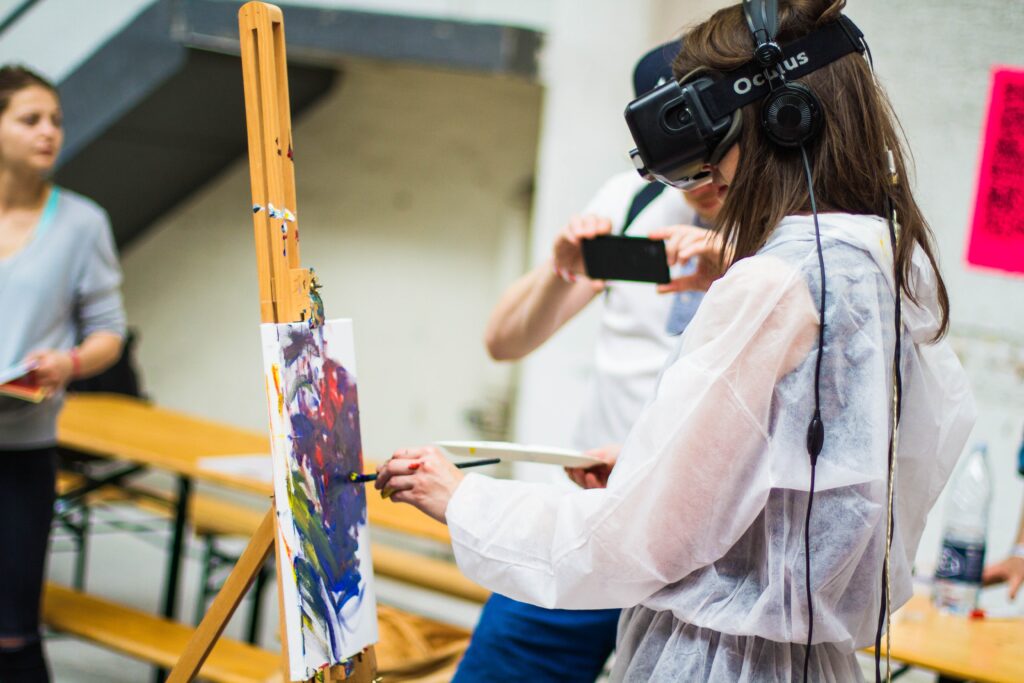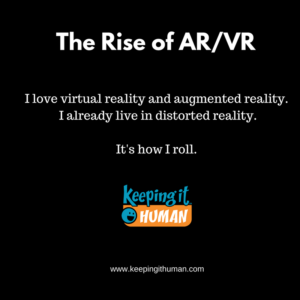From Telling to Sharing Experiences

Lots of big brands today are experimenting with mixed reality tech – virtual reality (VR) and augmented reality (AR) to create content. Forbes recently reported that 75% of the world’s most valuable brands (Forbes brand list) have created some kind of mixed reality experience for customers in an effort to grow engagement.
Imagine this: being able to test-drive the fastest car from BMW in a virtual reality environment before even setting foot on a dealer lot.
Right now, yes, content needs to catch up to the investment. Facebook, for example, has spent quite a bit to figure this one out. Make no mistake; though, the mixed reality content is coming.

Mixed Reality Storytelling
Storytelling Changes
So how will this tech change the ways companies approach storytelling?
While the full promise of mixed reality is a little ways off, it is already moving organizations from simply telling stories to creating shared experiences.
First-hand Shared Experiences
In theater, we call it breaking the fourth wall – a topic I have written about before. It’s where audiences interact with the actors. Here, we’re talking about brands. By creating new worlds that users interact with and could share with each other, organizations will start knocking down walls between themselves and customers.
These “we” moments make people feel more connected emotionally; something most brand storytelling today does not do a great job with. This is where all storytelling must go, and mixed tech can help facilitate this. The Holy Grail is eventually creating shared experiences where customers interact directly with and share experiences with employees (actual people) at brands. That’s true brand engagement.
Immersion
Storytelling will be far more immersive. People will be able to part of the story. That can deepen emotional connections. You are at a show, for example, and then you can put yourself into the center of the show.
Cirque du Soleil’s traveling Kurios show, for instance, put a 360-degree camera in the center of the performance so people could interact with it and become part of the performance itself.
Shel Israel, CEO of Transformation Group, a consultancy that focuses on mixed reality tech adoption, echoes the importance of immersion to put people in the story: “Until now story tellers and their audiences have always been separated by stages, screens, campfires or something. But now, every member of an audience can become immersed in the story. We can sit in front of a performer as is traditional, or we can get up and look over a speakers’ shoulder, or wander about the set and fiddle with an object on the night table. Children listening to a story can become part of the characters, wearing virtually bunny ears and tails.”
Will it happen for B2B brands? Likely not at the same rate – however- imagine people being able to share a space with the internal experts (not marketing!) and have a shared experience. That could have a big impact on renewals and lifetime customer values, she elaborates.
The Role of Empathy
Imagine being at the center of a story others have experienced and seeing exactly what they see. You are literally seeing it from another’s point of view. This is not only about consumer and business brands. It could substantially change how donors, politicians, leaders and citizens across the globe think about charities and social causes. Empathy moves people to engage, act and advocate.
For example, in 2015, the UN partnered with global organizations (including UNICEF and Samsung to name a few) to develop content that allowed leaders to experience a Syrian refugee camp first-hand. Another example is equally striking: in the UK a company produced “A Walk Through Dementia” to give people a first-hand perspective through the lens of someone living with this disease.
Deeper Story Branches and Consumer-Generated Worlds
It’s also exciting that it can change how narrative operates. Interactive choices open up possibilities for deeper backstories and story branches. Imagine hotspots and deeper character development: when you click on something, for example, you can experience flashbacks, time-jumps or back story narratives. And AR will yield quicker returns in the shorter run than VR because you are adding elements into existing worlds – and that lessens development cost and time.
As tools get better, cheaper and more ubiquitous, consumers will create their own story content to share – just as they do now in social media.
How are you getting ready for mixed reality storytelling and content? Let me know.


